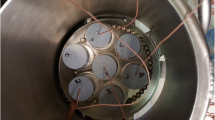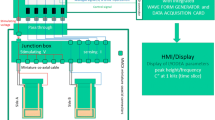Abstract
The goal of the work described in this publication was to evaluate a new, small, material-sparing freeze dryer, denoted as the “mini-freeze dryer or mini-FD”, capable of reproducing the product temperature history of larger freeze dryers, thereby facilitating scale-up. The mini-FD wall temperatures can be controlled to mimic loading procedures and dryer process characteristics of larger dryers. The mini-FD is equipped with a tunable diode laser absorption spectroscopy (TDLAS) water vapor mass flow monitor and with other advanced process analytical technology (PAT) sensors. Drying experiments were performed to demonstrate scalability to larger freeze dryers, including the determination of vial heat transfer coefficients, K v . Product temperature histories during K v runs were evaluated and compared with those obtained with a commercial laboratory-scale freeze dryer (LyoStar II) for sucrose and mannitol product formulations. When the mini-FD wall temperature was set at the LyoStar II band temperature (− 20°C) to mimic lab dryer edge vials, edge vial drying in the mini-FD possessed an average K v within 5% of those obtained during drying in the LyoStar II. When the wall temperature of the mini-FD was set equal to the central vial product temperature, edge vials behaved as center vials, possessing a K v value within 5% of those measured in the LyoStar II. During both K v runs and complete product freeze drying runs, the temperature-time profiles for the average edge vials and central vial in the mini-FD agreed well with the average edge and average central vials of the LyoStar II.









Similar content being viewed by others
Notes
This practice is intended to expose the mini-freeze dryer edge vial to additional heat transfer equivalent to that experienced by the edge vial in a tray. While this is expected to be a good approximation, it is not exact as some of the edge vials in a tray in a lab or production dryer nearly touch the band, thereby allowing for some gas-phase heat transfer, which is absent in the mini-freeze dryer. In addition, some of the vials are exposed directly to the wall of the freeze dryer, which runs warmer than the band. Alternately, and likely better, one could employ a circular “band” in the mini-FD and then use a wall temperature equivalent to the wall temperature found in the larger-scale dryer of interest. This was employed during a subset of experiments performed using the beta mini-freeze dryer.
Previous experience with standard gravimetric K v determinations using the LyoStar indicates that the normal standard deviation for replicate measurement is about 5% in K v , meaning that a difference between single K v values (i.e., for a given vial number) would be expected to have a standard deviation of about 7% and the difference between a single value and an average of 6 (edge vial comparison) would have a standard deviation of slightly more than 5%.
The LyoCalculator is a pseudo steady-state mass and heat transfer model for estimating the impact of changes in process conditions on the product temperature history in primary drying. It runs on an excel spreadsheet that will be made available to interested parties.
References
Maa YF, Prestrelski SJ. Biopharmaceutical powders: particle formation and formulation considerations. Curr Pharm Biotechnol 2000 Nov;1(3):283–302. PubMed.
Product Technologies for Lyophilization. Genetic engineering and biotechnology news. 2006. http://www.genengnews.com/gen-articles/product-technologies-for-lyophilization/1948. Accessed 15 Nov 2006.
Pikal M. Freeze-drying of proteins: process, formulation and stability. In: Cleland LJ, Langer R, editors. Formulation and delivery of proteins and peptides. Washington, DC: ACS; 1994. p. 20–133.
Pikal M. Freeze-drying of proteins. Part I: process design. BioPharm. 1990;3:18–28.
Pikal M. Freeze-drying of proteins. Part II: process design. BioPharm. 1990;3:26–30.
Pikal MJ, Roy ML, Shah S. Mass and heat transfer in vial freeze-drying of pharmaceuticals: role of the vial. J Pharm Sci. 1984 Sep;73(9):1224–37.
Patel SM, Jameel F, Pikal MJ. The effect of dryer load on freeze drying process design. J Pharm Sci. 2010;99(10):4363–79.
Pikal MJ, Bogner RH, Mudhivarthi V, Sharma P, Sane P. Freeze-drying process development and scale-up: scale-up of edge vial vs. center vial heat transfer coefficients, Kv. J Pharm Res. 2016;105:3363–43.
Roy ML, Pikal MJ. Process control in freeze drying: determination of the end point of sublimation drying by an electronic moisture sensor. J Par Sci and Tech. 1989;43:60–6.
Rambhatla S, Ramot R, Bhugra C, Pikal MJ. Heat and mass transfer scale-up issues during freeze drying: control and characterization of the degree of supercooling. AAPS Pharm Sci Tech. 2004;5(4):54–62.
Pikal MJ, Bogner RH, Mudhivarthi V, Sharma P, Sane P. Freeze-drying process development and scale-up: scale-up of edge vial vs. center vial heat transfer coefficients, Kv. J Pharm Res. 2016;105:3363–43.
Tang X, Pikal MJ. Design of freeze-drying processes for pharmaceuticals: practical advice. Pharm Res. 2004;21(2):191–200.
Acknowledgements
UConn and PSI scientists thank SP Scientific (Warminster, PA) for their support in developing the alpha and beta prototype Mini-FD. Authors also acknowledge the support of Jordan University of Science and Technology/Jordan.
Funding
The work described in this presentation was supported by award number HHSN261201300092C from the National Institutes of Health and National Cancer Institute.
Author information
Authors and Affiliations
Corresponding author
Ethics declarations
The content is solely the responsibility of the author(s) and does not necessarily represent the official views of the National Cancer Institute or the National Institutes of Health.
Conflict of Interest
The authors declare that they have no conflicts of interest.
Rights and permissions
About this article
Cite this article
Obeidat, W.M., Sahni, E., Kessler, W. et al. Development of a Mini-Freeze Dryer for Material-Sparing Laboratory Processing with Representative Product Temperature History. AAPS PharmSciTech 19, 599–609 (2018). https://doi.org/10.1208/s12249-017-0871-5
Received:
Accepted:
Published:
Issue Date:
DOI: https://doi.org/10.1208/s12249-017-0871-5




